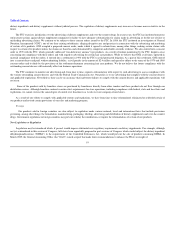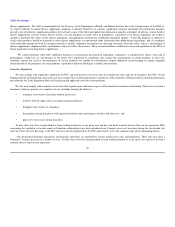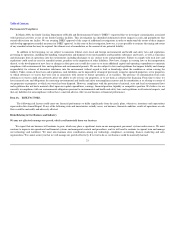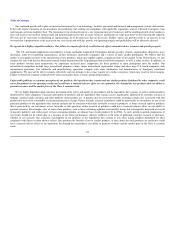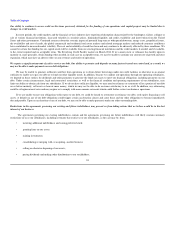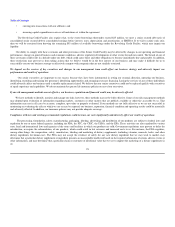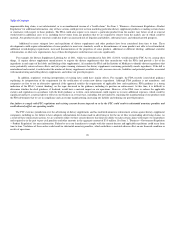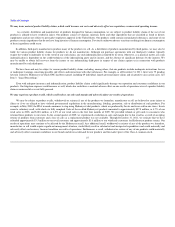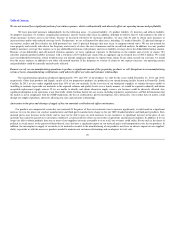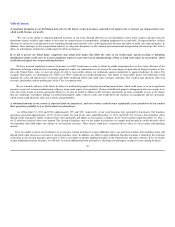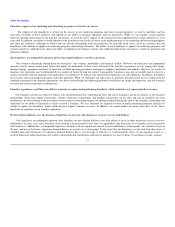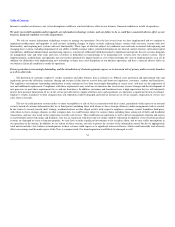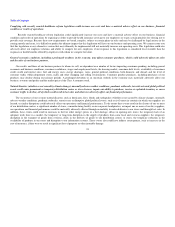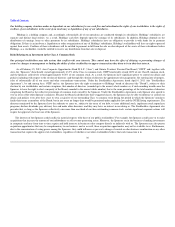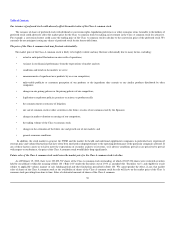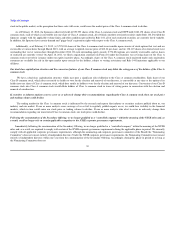GNC 2012 Annual Report Download - page 31
Download and view the complete annual report
Please find page 31 of the 2012 GNC annual report below. You can navigate through the pages in the report by either clicking on the pages listed below, or by using the keyword search tool below to find specific information within the annual report.
Table of Contents
We are not insured for a significant portion of our claims exposure, which could materially and adversely affect our operating income and profitability.
We have procured insurance independently for the following areas: (1) general liability; (2) product liability; (3) directors and officers liability;
(4) property insurance; (5) workers' compensation insurance; and (6) various other areas. In addition, although we believe that we will continue to be able to
obtain insurance in these areas in the future, because of increased selectivity by insurance providers, we may only be able to obtain such insurance at
increased rates and/or with reduced coverage levels. Furthermore, we are self-insured for other areas, including: (1) medical benefits; (2) physical damage to
our tractors, trailers and fleet vehicles for field personnel use; and (3) physical damages that may occur at company-owned stores. We are not insured for
some property and casualty risks due to the frequency and severity of a loss, the cost of insurance and the overall risk analysis. In addition, we carry product
liability insurance coverage that requires us to pay deductibles/retentions with primary and excess liability coverage above the deductible/retention amount.
Because of our deductibles and self-insured retention amounts, we have significant exposure to fluctuations in the number and severity of claims. We
currently maintain product liability insurance with a retention of $3.0 million per claim with an aggregate cap on retained loss of $10.0 million. We could
raise our deductibles/retentions, which would increase our already significant exposure to expense from claims. If any claim exceeds our coverage, we would
bear the excess expense, in addition to our other self-insured amounts. If the frequency or severity of claims or our expenses increase, our operating income
and profitability could be materially and adversely affected.
Because we rely on our manufacturing operations to produce a significant amount of the proprietary products we sell, disruptions in our manufacturing
system or losses of manufacturing certifications could adversely affect our sales and customer relationships.
Our manufacturing operations produced approximately 33% and 35% of the products we sold for the years ended December 31, 2011 and 2010,
respectively. Other than powders and liquids, nearly all of our proprietary products are produced in our manufacturing facility located in Greenville, South
Carolina. In 2011, no one vendor supplied more than 10% of our raw materials. In the event any of our third-party suppliers or vendors becomes unable or
unwilling to continue to provide raw materials in the required volumes and quality levels or in a timely manner, we would be required to identify and obtain
acceptable replacement supply sources. If we are unable to identify and obtain alternative supply sources, our business could be adversely affected. Any
significant disruption in our operations at our Greenville, South Carolina facility for any reason, including regulatory requirements, an FDA determination that
the facility is not in compliance with the cGMP regulations, the loss of certifications, power interruptions, fires, hurricanes, war or other force of nature, could
disrupt our supply of products, adversely affecting our sales and customer relationships.
An increase in the price and shortage of supply of key raw materials could adversely affect our business.
Our products are composed of certain key raw materials. If the prices of these raw materials were to increase significantly, it could result in a significant
increase to us in the prices our contract manufacturers and third-party manufacturers charge us for our GNC-branded products and third-party products. Raw
material prices may increase in the future and we may not be able to pass on such increases to our customers. A significant increase in the price of raw
materials that cannot be passed on to customers could have a material adverse effect on our results of operations and financial condition. In addition, if we no
longer are able to obtain products from one or more of our suppliers on terms reasonable to us or at all, our revenues could suffer. Events such as the threat of
political or social unrest, or the perceived threat thereof, may also have a significant impact on raw material prices and transportation costs for our products. In
addition, the interruption in supply of certain key raw materials essential to the manufacturing of our products may have an adverse impact on our suppliers'
ability to provide us with the necessary products needed to maintain our customer relationships and an adequate level of sales.
29


